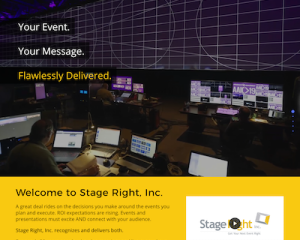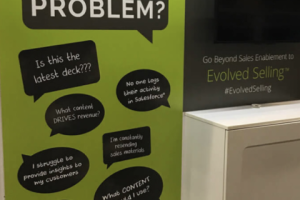
Face it. Your prospects are different today.
They don’t want to hear from you.
If anyone thought information overload and clutter was a problem even a few years ago, the daily tsunami of marketing messages flooding inboxes, cluttering social feeds, and even intruding at gas stations and grocers further erodes our ability to breakthrough.
With attention spans at all-time lows and the wealth of ways to get information, your buyers will most certainly be choosey.
Earning attention is how you will capture the interest of potential buyers.
To do that, you need to market smarter.
Smarter meaning, communicating with customers and prospects about what they care about – their OWN problems – not about yourself.
Step back a moment and recognize that there may be a void between the premise and the promise of what you’re offering. You articulate what your product or service does and how it benefits your customers — but, somehow, something gets lost in translation between what the customer wants and how you express why it helps.
Ineffective messaging exists in that void.
Despite knowing every facet of your product or service, you have precious few minutes and hours to simply and effectively communicate how your solution is a match.
Your marketing messages are only as effective as their ability to resonate with a prospect.
Many company marketing materials are habitually self-focused and selling-focused. They overdeliver on detail and underdeliver on the overall problem and the value of the solution from the customer’s perspective. And in fast-changing industries, the landscape is always shifting, making message optimization an ongoing operation.
With an inward-looking approach, why should anyone care? Your job, through your marketing, is to make them care.
Years ago, well-known business and marketing consultant Jay Abraham said:
“Marketing is the lifelong process of educating customers about why they should buy from you.”
He was prescient on the education point. Buyers routinely research on their own, gathering as much as 71 percent of needed information before ever making a sales inquiry. That makes information of value to their research process the best marketing currency.
Where does this apply? Everywhere you are … in all your company materials:
Because you’re not important. Your prospect is. So, let’s say it again: To earn attention, you have to turn the conversation around, always starting with the customer. Present what it is they care about achieving with your solution.
It’s no surprise the old ‘what’s in it for me’ still needs to be explained and instilled.
This must be because, as humans, we’d all rather just talk about ourselves.
It’s easier.
After all, we have so much to offer. We know we can solve their problems. We know how much better our product or service is than the others out there.
All undoubtedly true. If only they’d listen.
They will. If you do the work.
Understand your customer, your market, and your competition. Of course. It’s elementary. But arriving at what messaging connects and resonates with a prospect means examining what you’re communicating, with inputs from both internal and external sources, and then kicking the tires on your approach.
Internal – Talk with and involve sales reps as you plan or prepare your communications
- Find out what they are hearing from customers
- Ask what they think. If they could have the ideal marketing message or the ideal sales piece, what exactly would it be?
- How can you be more responsive to exactly what they’re hearing?
Query representatives from all parts of your organization.
Management and sales hold a great deal of customer knowledge. But don’t ignore other members of your team. For one of our manufacturing clients, we interviewed not just management but every department head, including Human Resources. The HR representative’s insights were the ones that ultimately unlocked key value messages. Gold messaging nuggets could be hiding anywhere.External – Existing customers know why they bought. Interview them for their direct and honest input
- Find out what they really care about
- Ask for specifics about exactly why they chose to work with your company instead of a competitor
- Strive to go beyond the surface. If you provide a tangible product, what intangibles do customers receive? If you provide a service, what do they most value in it besides the table stakes?
- While you’re at it, ask about who or what they are influenced by and where they go for trusted information. These insights will help you determine how best to reach their peers.
Re-visit your competition
If you haven’t studied them lately and rely on opinions formed in the past, you may be surprised by their own progress in earning buyer attention.
- Does your company sound just like them?
- If you’re competing in exactly the same category, are you doing (or can you do) a better job of appealing to what customers actually care about?
- Are you playing up what makes you different and superior?
To ensure you’re not just touting the exact same points, it can be quite helpful to create an axis showing the current messages you’re using alongside those of your direct competitors. Do this, and it will become clear where the opportunities are for you to re-position and strengthen your differentiators.
Talk to the ones that got away
Don’t ignore this group. A postmortem with prospects that went with a different solution can deliver valuable feedback.Another potential source to help validate your messaging are prospective employees. Based on their likely more general knowledge about what your firm does, their input can help validate message uptake.
Gather all the inputs and look at them objectively. Take all you’ve learned, examine, then re-shape, your differentiators.
Begin by breaking down messaging for every customer group. There’s a reason personas are so important – most offerings touch more than one user or decision-maker. And every buyer cares about different things.
Clearly define the value you provide to these groups. How does your product or service solve their business problems? Impact their business as a whole? Their growth goals? Importantly, too, how does your product or service impact them on a personal and emotional level? [link to empathy article post]. From this, build a new set of key messages relevant to each buyer persona.
Collect and get rid of insular industry jargon. Stop talking like a company trying to sell.
Talk like a person, to one person, communicating in a way that makes sense to your audience. But be careful. Loading up buzzwords and phrases related to what your product does versus how it solves customer problems will make your message veer off course.
Once you’ve written out your distilled messages, go back to the groups you originally queried to get their reactions. Take note on what resonates, what doesn’t, and determine why. Then rework, revise and test again.
Ultimately, this work will pay off with messaging that is, clear, relevant, and understandable.
Apply these new messages to refresh your competitive positioning and integrate them over all your external marketing assets content, including your website, sales materials, blog, video, emails, and social media posts.
Before you send out any piece of communication, ask yourself:
Think about the communications you receive that cause you to act. Aren’t those companies doing exactly this – and in creative and entertaining ways — to gain and keep your attention?
If you do it right, your prospects will understand the value of what you offer, in the way they want to hear it.
Call us at 847.639.8300 or email su***@********nt.com, and let’s talk about what’s best for you.

Demanding an innovative departure from predictable product introductions, USG tapped Element-R to help unveil new, patented technology.
We created a high impact event for industry leaders by an industry leader, using several non-traditional elements to make the launch distinctive:
The event achieved the objectives of generating excitement around the new technology while seeding long-term market interest among the 70+ guests from 35 companies. The majority of survey respondents rated the event as outstanding.

In the early days of personalized medicine, few people understood the new science of pharmacogenetics – how medicines interact with an individual’s genes, often causing avoidable side effects. YouScript software by Genelex (now owned by Invitae) was a pioneering technology giving physicians detailed input on these interactions for the benefit of patients.
To gain industry media attention for the relatively unknown company, Element-R recommended a purely educational webinar for the media only. Delivered entirely by an M.D., the webinar effectively informed editors and reporters about the topic – with a bonus: several covered the burgeoning science and the company’s leadership in feature-length articles.

All high-end professional AV and event staging companies show off their best events to attract prospects. Stage Right, Inc. needed to revitalize its digital doorstep and deliver key differentiators.
Element-R created a new, from the ground up website that made the company stand out on two fronts. First, instead of simply showing off glitz, we organized and showcased its capabilities by category, allowing prospects to identify and pair their challenges with a clear solution. Second, we branded and spotlighted the company’s proprietary planning protocols, now known as StageCraft™. Stage Right, Inc. has a modern, responsive site that places its distinctive competencies out front.

When the nation’s oldest senior living community in the U.S. needed to reinvigorate its marketing, Element-R Partners helped Three Crowns Park play to its strengths in a crowded marketplace.
Through a deep dive with residents and staff, we developed messaging that appealed to retirees who don’t want to live in a cold institution or ritzy resort/hotel setting. The new website faithfully presents this welcoming and close-knit community of friendship and relaxed, suburban style living.

To meet a changing world of special education with funding and competitive challenges, the O-School needed to reacquaint its many publics about the organization’s mission and capabilities.
Interviewing staff and multiple influencer groups, Element-R developed a “messaging playbook” that served as the basis for all aspects of its external communication to encourage student enrollment and support funding. The backbone of this effort were two new websites, www.oschool.org and www.bw-center.org, creating a cohesive presence for the School in all of its materials, and bringing it into the 21st Century.
 Go bold! Evolved Selling™ software maker Mediafly offers a sophisticated content management and sales enablement solution to organizations worldwide. To really make a statement at its channel partners’ annual conferences, Dreamforce and Sapphire, Mediafly nixed the typical descriptive booth copy, instead drawing visitors in with bold problem statements its audience could relate to.
Go bold! Evolved Selling™ software maker Mediafly offers a sophisticated content management and sales enablement solution to organizations worldwide. To really make a statement at its channel partners’ annual conferences, Dreamforce and Sapphire, Mediafly nixed the typical descriptive booth copy, instead drawing visitors in with bold problem statements its audience could relate to.
Together with design partner DoubleTake Design, Element-R developed channel partner messaging and several alternative creative concepts for the booth. We couldn’t have been happier that Mediafly selected this unusual and compelling way to present itself. Traffic was steady at the booths as visitors walked up to say, “can you really solve that problem for us?” The creative concept continues to be used successfully to bring attention to Mediafly’s many capabilities – proving that B2B marketing doesn’t have to be boring!